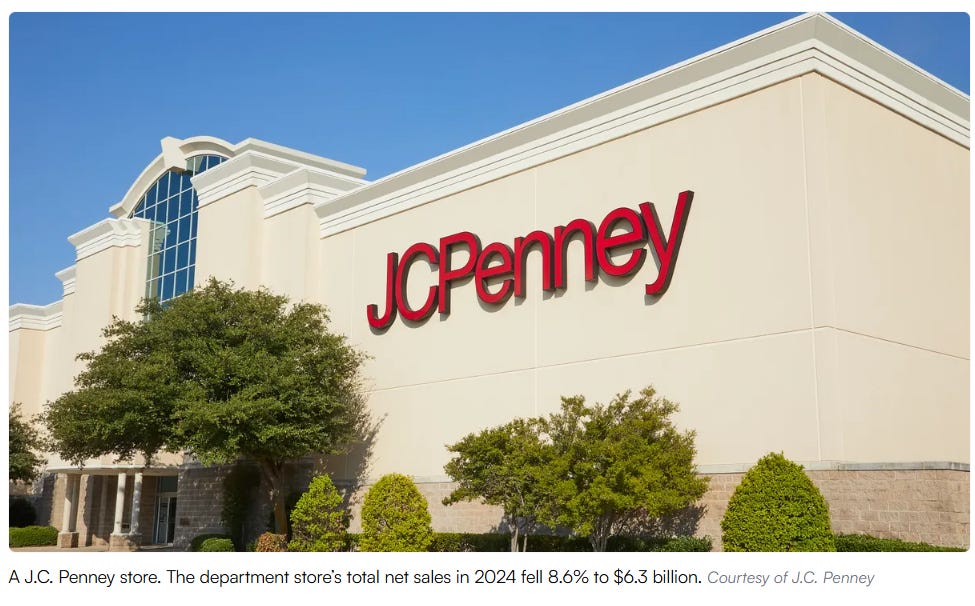S1.C55. TELL ME WHY - TEXAS WAREHOUSE
BY CLOUDY - IJ.C. Penney’s Texas warehouse closure reveals reactive cost-cutting and outdated logistics strategy—raising concerns about missed opportunities for smarter, more adaptive operational plan
J.C. Penney, the iconic American department store chain, has announced the permanent closure of its Alliance Supply Chain facility in Haslet, Texas. This decision, scheduled to take effect by November 1, 2025, will impact approximately 300 employees and marks another chapter in the company’s ongoing efforts to restructure its operations in response to persistent financial challenges. The company disclosed the news through a Worker Adjustment and Retraining Notification (WARN) letter and confirmed that layoffs would occur in two phases: the first wave between August 1 and August 14, and the second from November 1 to November 14.
The retailer emphasized that some affected employees may be offered alternative roles at other J.C. Penney locations. In an official statement, the company described the closure as a “difficult but necessary decision” aimed at building a more competitive and sustainable organization. J.C. Penney expressed gratitude to the impacted workers and committed to offering severance packages, benefits, and other transition resources. The statement underscored that the move comes after a “thorough review” of the organization’s operational needs and long-term strategy.
This development arrives in the midst of J.C. Penney’s broader financial downturn. In 2024, the company’s total net sales (excluding credit card revenues) fell by 8.6% year-over-year to $6.3 billion. That decline in revenue was accompanied by a sharp reversal in profitability: the company posted a $177 million net loss, compared to a $30 million net income the year prior. In addition, consolidated adjusted EBITDA—a key measure of operating performance—fell by more than 45%, landing at $172 million. These figures paint a grim picture of the company’s current fiscal health and underscore the urgency behind its restructuring decisions.
Part of J.C. Penney’s transformation strategy involves partnerships and realignments at the corporate level. At the start of 2025, the retailer entered into a joint venture with Sparc Group—the operator of brands like Brooks Brothers and Eddie Bauer—to form a new entity called Catalyst Brands. This collaboration aims to pool resources and operational expertise to streamline performance and strengthen market presence. However, the venture has already undergone its own round of belt-tightening, cutting approximately 9% of its corporate workforce earlier in the year.
The closure of the Haslet warehouse highlights the difficult balance traditional retailers face between cost-cutting and maintaining customer service standards. Supply chain efficiency is critical in retail, and downsizing logistics operations can yield short-term savings but may also introduce fulfillment challenges if not offset by improvements elsewhere. J.C. Penney’s strategy seems focused on centralizing and modernizing its operations, potentially leaning more heavily on technology, automation, or third-party logistics.
In summary, the closure of J.C. Penney’s Haslet facility is emblematic of the broader struggles facing legacy retailers in a rapidly changing consumer landscape. With declining sales, rising losses, and shifting partnerships, the company is taking tough measures to stay afloat and reshape its business for long-term survival. Whether these efforts will restore the brand’s competitiveness remains to be seen.
Here are 3 questions for you :
“How can we redesign our supply chain to be more agile and responsive to shifting demand?”
This question could have prompted a transition toward omnichannel fulfillment, regional micro-warehousing, or automation, reducing the need for abrupt closures while improving efficiency and speed.
“What early indicators should trigger operational downsizing or reinvestment before profitability collapses?”
A strong early-warning system—tracking metrics like warehouse utilization, fulfillment cost per order, or inventory turnover—might have helped identify underperformance long before an 8.6% sales drop and $177M loss occurred.
“Can we repurpose or re-strategize underused assets before opting for closure?”
Instead of shutting the Haslet facility entirely, J.C. Penney could have explored co-warehousing with partners, converting it into a last-mile hub, or using it to support online returns and exchanges.
Provide the question# on your comment when you answer.
READ MORE SCORE MORE
PREVIOUS
S1.C54. TELL ME WHY - INTEL
·In a decisive move reflecting the volatility of the tech sector and intensifying market pressures, Intel Corporation has announced sweeping layoffs and the shutdown of its automotive chip division. These actions are part of a broader cost-cutting and restructuring strategy led by newly appointed CEO Lip-Bu Tan, who aims to streamline operations, reduce …
NEXT
S1.C56. TELL ME WHY - PUBLIC HOSPITALITY GROUP
·Public Hospitality Group, led by Jon Adgemis, is facing a significant financial crisis, as five of its prominent venues have been placed under receivership. Insolvency specialists Vaughan Strawbridge and Joseph Hansell of FTI Consulting have been appointed as Receivers and Managers for these locations, signaling the latest development in the group's ong…
if you have difficulties accessing any of these documents to read, please feel free to revert to us
Here is a quick guide if you want to change the article into languages of your choice…. but you already know this








With JC Penney’s cash flow problems, can it afford to invest in automation or multi-channel fulfillment without making its money troubles worse?
-How might the closure of a major distribution center impact customer service, order fulfillment, and brand perception in a competitive retail environment?- team 1